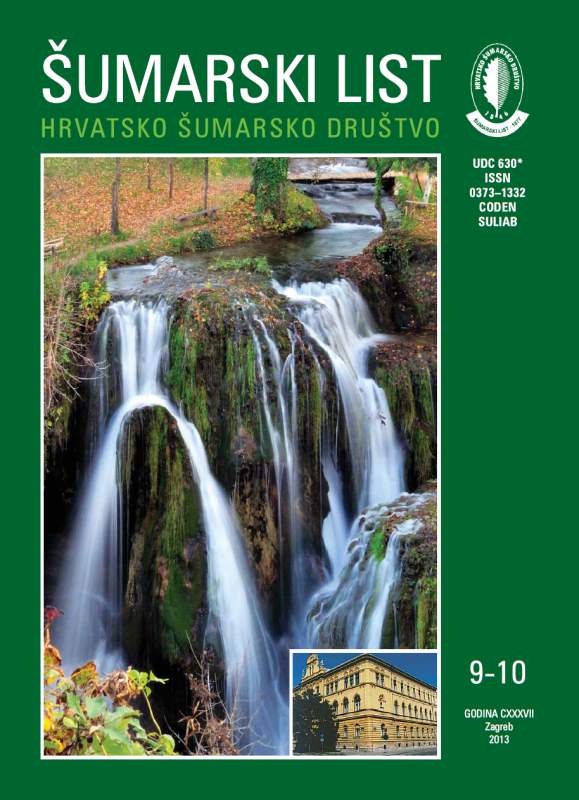
broj: 9-10/2013
pdf (8,91 MB) |
|
||||||||||||||
| RIJEČ UREDNIŠTVA | ||
| uredništvo | ||
| THE NEW EU FORESTRY STRATEGY: FOR FORESTS AND THE FOREST-BASED SECTOR pdf HR EN | 445 | |
| At the end of September the competent Ministry received a report dealing with the above topic. Sent by the European Commission Secretary General, the report was addressed to the Secretary General of the Council of the European Union and all the EU Member States. The report was forwarded to the Croatian Forestry Association, the Academy of Forestry Sciences and other forestry institutions. The report, describing the forest condition and the framework, which we will present here in brief, contains 16 pages and starts from some general forest data. Forests and other wooded land cover over 40 % of the EU land area, in- creasing by around 0.4 % per year, whereas globally, forest area continues to decrease. Only 60–70 % of the annual increment is being cut, but harvest rates are expected to increase by around 30 % by 2020. Forests are multifunctional and their socioeconomic importance is high, but often underestimated. Forest biomass currently accounts for around half of the EU’s total renewable energy consumption. In order to ensure these benefits in a balanced manner, it is crucial to apply sustainable forest management. A clarification follows as to why a new framework is needed in the aftermath of significant societal and political changes in the past 15 years and growing demands on and threats to forests. We shall briefly mention three out of the six reasons: a) ensure that the multifunctional potential of EU forests is managed in a sustainable and balanced way; b) satisfy the growing demand for raw material, and c) respond to the challenges and opportunities that forest-based industries face in terms of various efficiencies. What step forward should be taken that relates to an integral approach to forest management and the entire forest value chain? The guiding principles are: sustainable forest management and the multifunctional role of forests, resource efficiency where the contribution of forests to rural development, growth and job creation is optimized, as well as global forest responsibility that promotes sustainable production and consumption of forest products. The 2020 forest objectives are to ensure and demonstrate that all forests are managed according to sustainable forest management principles. This contributes to balancing various forest functions and provides a basis for forestry and the whole forest-based value chain to be competitive contributors to welfare. The eight linked priority areas of the strategic orientation are to: - Support rural and urban communities (through strategic orientations: using rural development funds, where the Commission and the Member States should assess and improve the effect of forestry measures under rural development policy, as well as improve their valuing of the benefits that forests give to society). - Foster the competitiveness and sustainability of forest-based industries, bio-energy and the wider green economy. - Forests are vulnerable to climate change. It is therefore important to maintain and enhance their resilience and adaptive capacity. - Efforts to protect forests and biodiversity should aim to maintain, enhance and restore forest ecosystems’ resilience and multi-functionality, as well as prevent negative impacts on forests. - Improve the forest knowledge base to better understand the complex environmental and societal challenges – set up the Forest Information System of Europe. - Stimulate new innovative forestry and added-value products. According to the forestry measures plans, €5.4 billion from the European Agricultural Fund for Rural Development have been earmarked for forestry measures in 2007–2013. A similar level of spending could be expected for 2014– 2010. In conclusion, the European Parliament and the Council are invited to endorse this strategy and to express their views on its implementation. In our opinion, we have almost no objections to the proposed strategy. This strategy contains all the elements which the Croatian Forestry Strategy should contain and which we have been seeking for and advocating for years, but to no avail. Instead of the Croatian Forestry Strategy to serve as an exemplary model for the EU Member States, we shall only now, as the EU member, be forced to develop our own Forestry Strategy, which is sad and shameful. It is obvious that we only function under coercion, even in segments such as forestry, where resources and knowledge should objectively place us among the top states. Editorial Board | ||
| IZVORNI ZNANSTVENI ČLANCI | ||
| Damir DRVODELIĆ, Milan ORŠANIĆ, Sanja PERIĆ, Martina TIJARDOVIĆ | UDK 630*232.3+181.3 (001) | |
| INFLUENCE OF IRRIGATION AND MICRO-RELIEF IN NURSERIES ON MORPHOLOGICAL CHARACTERISTICS OF PEDUNCULATE (Quercus robur L.) AND SESSILE OAK (Quercus petraea L.) FOREST SEEDLINGS pdf HR EN | 447 | |
| Roman ROSAVEC, Zoran ŠIKIĆ, Željko ŠPANJOL, Damir BARČIĆ, Marko VUČETIĆ | UDK 630*431 (Pinus halpensis Mill) (001) | |
| WILDFIRE THREATS WITHIN THE HABITAT CONDITIONS IN ALEPPO PINE STANDS (Pinus halepensis Mill.) OF ADRIATIC KARST AREA pdf HR EN | 461 | |
| Jelena Nedeljković, Marko Lovrić, Dragan Nonić, Makedonka Stojanovska, Vaska Nedanovska, Nataša Lovrić, Vladimir Stojanovski | UDK 630*899 (001) | |
| INFLUENCE OF POLICY INSTRUMENTS ON NON-WOOD FOREST PRODUCTS COMMERCIALIZATION IN CROATIA, MACEDONIA AND SERBIA pdf HR EN | 473 | |
| Osman MUJEZINOVIĆ, Josip MARGALETIĆ, Tarik TREŠTIĆ, Mirza DAUTBAŠIĆ | UDK 630*451+151 (001) | |
| THE IMPACT OF THE HABITAT TO THE PRESENCE OF BANK MOLE (Myodes glareolus) AND YELLOW-THROAT MOUSE (Apodemus falvicollis) IN THE AREA OF BOSNIA pdf HR EN | 487 | |
| PRETHODNO PRIOPĆENJE | ||
| Milivoj FRANJEVIĆ | UDK 630*453 | |
| BIVOLTINISM OF EUROPEAN HARDWOOD AMBROSIA BEETLE Trypodendron domesticum IN CROATIAN LOWLAND OAK STANDS OF JASTREBARSKI LUGOVI pdf HR EN | 495 | |
| Boris Hrašovec, Darko Posarić, Ivan Lukić, Milan Pernek | UDK 630*453 | |
| FIRST RECORD OF OAK LACE BUG (Corythucha arcuata) IN CROATIA pdf HR EN | 499 | |


